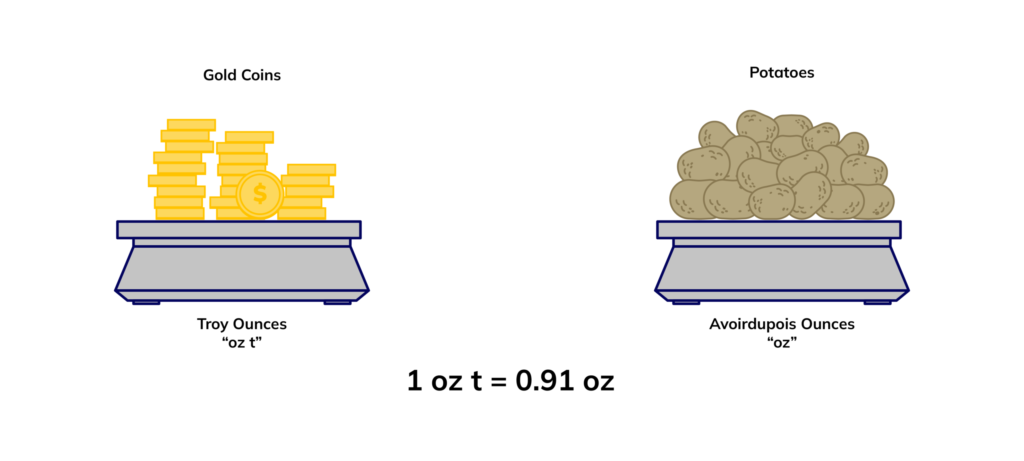Topics
Here’s what we’ll cover in this article.
- What is a Troy Ounce?
- How the Troy Ounces relate to Ounces, Pounds and Grams
- The Troy Ounce in practice
- For History Buffs: The history of the Troy Ounce
- Key Takeaways
What is a Troy Ounce?
The Troy Ounce is a basic unit of measurement used in the precious metal industry to weigh precious metals like gold, silver, platinum, and palladium.
It has a history going back to the Middle Ages in France and even further till Roman times. We’ll cover this aspect of the story at the end of this article.
It’s important to not confuse the Troy Ounce with the “normal” Ounce which we use in our daily lives to weigh milk, oil, sugar, salt, etc. You may not know this, but this type of ounce is called the “Avoirdupois” ounce. “Avoirdupois”, loosely translated from French, means “to have weight”.
(Note: “pois” is old French for “weight”. In modern French, it is spelled as “poids”. But that’s an article for another time!) The Troy ounce is a part of the Troy weighing system with units like the Troy Pound, the Troy grain, and the Pennyweight. These other units are no longer in use and the Troy Ounce is the last man standing from that era.
Troy Ounce Vs Ounce
As you know, the Ounce is abbreviated “oz”.
The Troy Ounce goes by “oz t”
Now be careful: When the precious metal industry uses the term “ounces”, they are referring to Troy ounces and not normal Ounces. They may even use the abbreviation “oz” (instead of “oz t”) but don’t let that confuse you. They are still referring to Troy Ounces.
This distinction is critical if you’re buying precious metal. If you see a quote for gold in “ounces”, you may think you are getting normal ounces. But, in fact, you’ll end up with Troy ounces. That means you’re going to get approximately 10% less gold than you thought you were going to get! Ouch!
And why is that?
Because:
1 Troy Ounce = 0.91 Ounce
So, a Troy Ounce is slightly heavier than a “normal” (avoirdupois) ounce.
The difference might seem insignificant if you’re buying and selling potatoes. But if you’re trading in large quantities of gold or silver, you’d better be sure you’re using the correct version of the ounce – The Troy Ounce.

Troy Ounce Vs Pounds and Grams
Now let’s compare the Troy Ounces to Pounds and Grams.
But which Pound? The Troy Pound or the “normal” Pound – the kind we put on after the holidays?
Let’s look at both.
1 Troy Pound has 12 Troy Ounces
1 Normal Pound has 14.6 Troy Ounces
So, a normal Pound is heavier than a Troy Pound.
We’ve already seen that a Troy Ounce is heavier than a normal ounce. Converted to grams they look like this:
1 normal Ounce = 28.35 grams
1 Troy Ounce = 31.103 grams
The Troy Ounce in practice
Here’s an example of the price of gold shown in Troy Ounces.

The history of the Troy Ounce
Origins of the word “Ounce”
Throughout their history, from the Republic to the Empire, the Romans used different types of currency made of gold or silver or copper or bronze. There was a time when the currency of choice was the bronze bar. These were called the “aes grave” and they weighed 1 Libra.
1 Libra in Roman times is equivalent to 1 Pound in modern times. (Ever wonder by the symbol of a Pound is “lb”?)
In Roman times 1 Libra was made up of 12 Uncias. So, an Uncia was 1/12th of a Libra (Pound) and the modern word “ounce” is derived from the Latin word “Uncia”.
So, the Troy Pound and the Troy Ounce are descendants of the Roman Libra and Uncia.
This explains why the Troy Pound has 12 Troy Ounces.
(Unlike the modern Pound which has 16 Ounces) So where does the word “Troy” come from. There are two theories. (and, in case you’re wondering, neither has anything to do with Helen of Troy!)
Origins of the word “Troy Ounce” – Theory #1
In the Champagne region of France is the town of Troyes. During the Middle Ages, Troyes was a market town sitting at the crossroads of Europe. It was famous for its “Champagne fairs” hosted by the Counts of Champagne.
Gold and silver were traded here. And the theory goes that the weighing system used by merchants of Troyes, which was inherited from the Romans, became known as the Troyes system. This system was imported into England in the 1400s and was later anglicized to the Troy system.
Origins of the word “Troy Ounce” – Theory #2
An alternate theory proposed by Sir Charles Moore Watson is that the word “Troy” has a completely different source than the city of Troyes in France.
In England in the late 1200s, statutes were adopted to standardize weights. This was called the Tractatus de ponderibus mensuris or in English the Assize of Weights and Measures. These statutes use a term “troni ponderacionem” which loosely translated means “the market weight of”. And the theory goes that while being translated to English “troni ponderacionem” became “Troy weights”.
An excellent article by the London Bullion Market Association gives us another possible source of the word “Troy”. It says that the Oxford Dialect Dictionary defines the “troi” as “balance”. And so, the origin of “Troy weight” could simply come from a balance or scale used to weight the products.
Of course, this theory is far less exciting than the one with medieval fairs, champagne and inheritance from the Romans. But it may be more probable. To conclude, regardless of which theory you ascribe to the origins of the word “Troy ounce”, the importance of the Troy ounce in the modern era, especially when it comes to trading in precious metals, is undisputed.
Key Takeaways
- The Troy Ounce is the standard unit of measurement used to weigh precious metals.
- The Troy Ounce (“oz t”) is distinct from the regular Ounce (“oz”) which comes from another system of weights called “Avoirdupois”
- 1 Troy Ounce = 0.91 Avoirdupois Ounce
- 12 Troy Ounces = 1 Troy Pound
- 1 Troy Ounce = 31.103 grams
- When the price of a precious metal makes a reference to an ounce it is always referring to the Troy ounce.
- The Troy Ounce has a history going back to Roman times. However, the exact origins of the word “Troy” is unknown.
